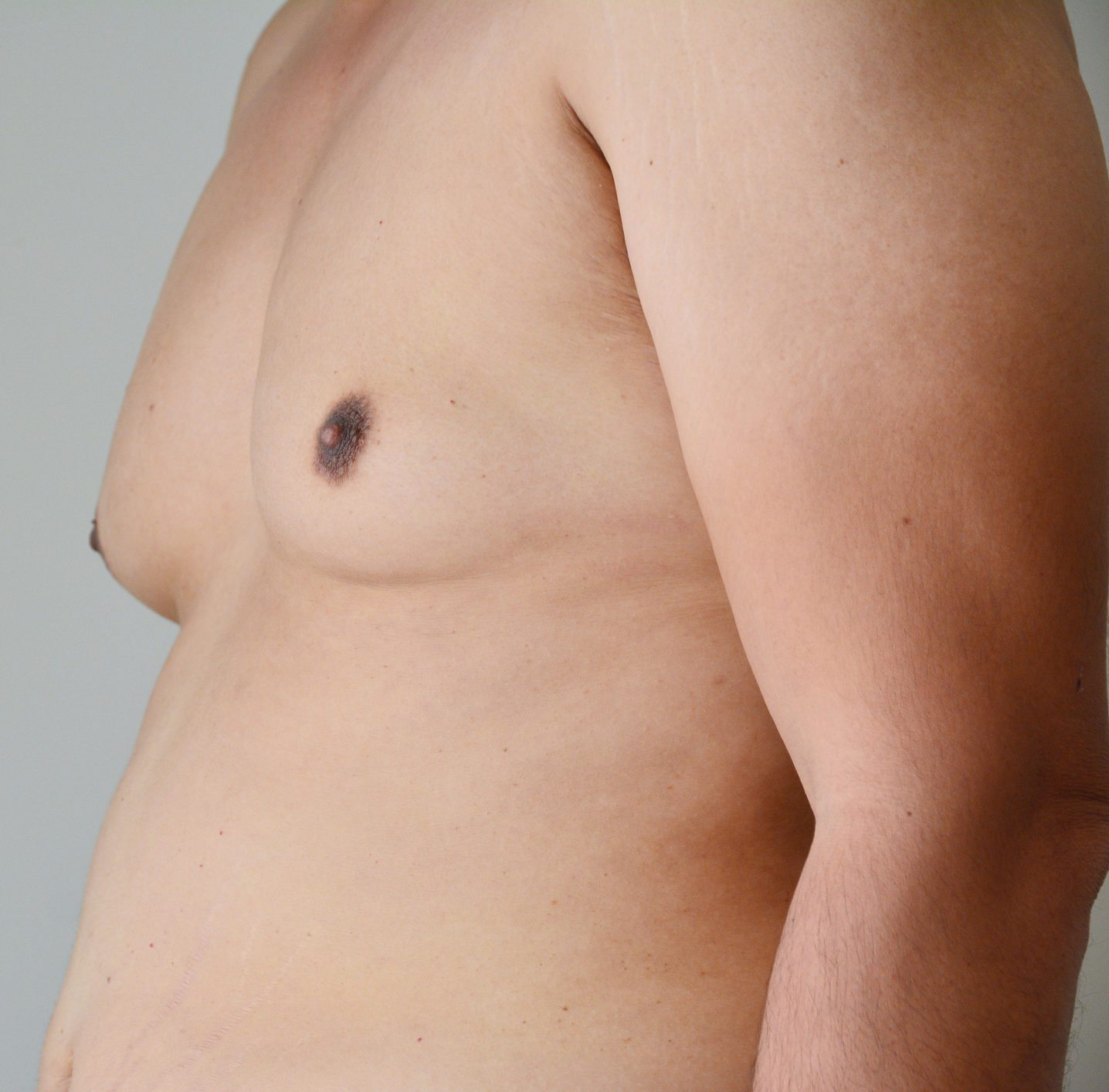
Being a town on the coast, Guilford patients tend to spend a lot of time at the beach. Unfortunately, this is about the last thing some men want to do because of their enlarged breasts, known as gynecomastia. Often, people condescendingly refer these as “man boobs.”
There is a great deal of misconception surrounding male breasts. Many people attribute these male breast growths to excess weight gain. While this can be the cause behind some male breast enlargement, it can also be due to a condition that is known as gynecomastia.
As a solution to gynecomastia, Dr. Price performs male breast reduction surgery. This procedure is performed to reduce enlarged male breasts, enhancing their appearance and boosting their confidence.
What is Gynecomastia?
The term gynecomastia has Greek origins and means “woman-like breasts.” The condition can affect one or both breasts, and is not rare — in fact, it has been reported that almost half of all men experience gynecomastia. Sometimes it is so subtle that many men do not notice it, and place the blame on weight gain. As a result, most of these men never take action against their condition, simply believing that it is a fault of their own.
Gynecomastia is estimated to effect three out of four teenage boys, making them the most affected demographic. During puberty, high levels of estrogen and testosterone course through their bodies, resulting in excess fatty deposits on their chests. For most young boys, gynecomastia will pass as they push past puberty, much like acne or excess body odor. Unfortunately, some men deal with enlarged breasts well into adulthood. Male breast reduction is suggested for these cases.
How Common Is Gynecomastia?
According to statistics from the National Institutes of Health, gynecomastia is quite common. The condition affects approximately 50% to 60% of adolescent males. When excessive breast tissue develops during this time, it is expected to resolve spontaneously when a man enters his 20s and his hormones become more stable.
Statistics also suggest that approximately 65% of men between the ages of 27 and 92 years of age. The development of enlarged breasts in adulthood could be attributed to a number of factors. In addition to excess estrogen in the blood, gynecomastia in the adult male could be caused by thyroid imbalance, weight, certain medications, and other factors.
Causes of Enlarged Male Breasts
In adults, their breast enlargement usually occurs in middle age and above. Like teenagers, this is a time of fluctuating hormones. Beyond hormones, certain medications are linked to enlarged breasts as well. Below is a list of all possible influences for the development of gynecomastia in men.
- Steroids
- Antibiotics
- Heartburn treatment drugs
- Tricyclic antidepressants
- Anti-anxiety drugs
- AIDS treatment drugs
- Abnormal Hormone Levels
- Heaving Drinking
- Frequent Marijuana Usage
- Weight Gain
- Aging
What Are The Symptoms Of Gynecomastia?
The stigma of having larger than normal breasts can really impact a man’s self-esteem, and reduction surgery can definitely improve self-image. Many cases of gynecomastia present themselves in a firm, rubbery mass directly underneath the nipple area. The area is sensitive to the touch and usually measures around two inches in diameter.
Steroids, in particular, are known to cause gynecomastia, probably due to their heavy hormone concentration.
Am I A Candidate For Male Breast Reduction?
Ideal candidates for gynecomastia surgery are men who are unhappy with the appearance of their enlarged breasts. This could be due to one of both sides of the chest containing excess fat deposits that have the appearance of feminine breasts.
If you are suffering from low self-esteem and lack of confidence due to gynecomastia, you may be a good candidate for this procedure. Liposuction or breast reduction surgery might be advised depending on the severity of the fat, skin, and excess tissue.
Benefits of Gynecomastia Surgery
There are several benefits achieved through male breast reduction, none of which are as significant as the improvement in self-confidence a man attains through chest contouring. Gynecomastia can have a profound effect on a man’s sense of identity. Restoring masculine shape to the breasts allows a man to wear clothing that suits his personality rather than clothes that hide his shape.
Correcting gynecomastia allows a man to see the results of diet and exercise habits and to feel comfortable wearing tight shirts or no shirt. Finally, the procedure itself is short and the recovery from male breast reduction surgery is generally minimal. Many patients are able to return to work within 1 week with minimal residual swelling and soreness.
Read what our patients are saying!
“Dr. Price did excellent work and his staff made me feel relaxed and comfortable” – Peter
Click here to read more reviews.
Does Male Breast Enlargement Cause Pain?
Gynecomastia may occur with or without pain. The sensation that most men describe is breast tenderness, which may coincide with swelling. If breast pain intensifies and is accompanied by persistent swelling or discharge from the nipples, a full medical examination should be conducted to rule out potentially serious medical conditions.
Can Male Breast Enlargement Cause Cancer?
According to the Mayo Clinic, the risk that gynecomastia could cause breast cancer is very small, occurring in less than 1% of all cases. Typically, the increase in breast size is associated with an overgrowth of benign glandular or fatty breast tissue and nothing more.
Treatment Options For Gynecomastia
Several treatment options have been developed to help men correct gynecomastia. Research has demonstrated a clear lack of efficiency in over-the-counter treatments such as supplements to regulate hormones. Exercise has also been excluded as a viable treatment option. Men with true gynecomastia require proper medical evaluation and care to fully resolve their condition.
The best treatment option for gynecomastia is to have excess fatty and/or glandular tissue surgically removed. The process is simple and, in our office, conducted in such a way that incisions are made in discreet locations to minimize the appearance of surgical scars. In cases of excess fatty tissue alone, gynecomastia surgery may involve nothing more than liposuction. When glandular tissue has enlarged, small incisions can be made to excise the breast glands. If necessary, a small amount of skin can also be removed in the process.
Male Breast Reduction Procedure
In most cases, this surgery is done on an outpatient basis and with local anesthesia only. The condition is often directly tied to excess glandular tissue. Dr. Price can remove this through small incisions made either around the areola or in the armpit. This makes scarring virtually invisible. Through these small incisions, Dr. Price removes excess glandular tissue, fat, and possibly some skin. In many cases where the enlargement is mostly fat, liposuction may be all that is needed. Dr. Price can determine the best plan for your individual problem after a consultation and examination.
Liposuction for Male Breast Reduction
Liposuction is a common technique used to reduce male breast size in patients with good skin elasticity, meaning their skin is likely to “bounce back” after fat reduction. The procedure may be conducted either with local anesthesia and sedation or general anesthesia. This aspect of treatment is discussed during the initial consultation for surgery.
When liposuction is the sole technique used to correct gynecomastia, the treatment time is one to two hours. Liposuction is typically performed through a few tiny incisions. Through each incision, a thin, hollow cannula is passed back and forth through fatty tissue. With careful technique, Dr. Price removes the appropriate amount of fat to achieve masculine chest contouring. After incisions heal, the surgical scars should be virtually imperceptible.
Patients with more severe gynecomastia or loose skin may need to combine liposuction with tissue excision. When possible, skin and tissue excision is performed through discreet incisions made around the areola. This allows scars to form only at the natural border of pigmentation around the nipple.
Recovery From Gynecomastia Surgery
Recovery from the surgery is not difficult. Immediately after your procedure, we’ll put you in a compression garment to minimize swelling and to help the chest skin adhere to its new contour. The incisions are small and they heal relatively quickly. There will be some swelling and discomfort, but this does not last very long. You may have some loss of sensation in the area, but this usually returns.
Generally speaking, patients see obvious changes in the size of their breasts after about two weeks. After about six weeks, roughly 75 percent of the improvement is visible, while the full result may take three to six months.
Does Gynecomastia Come Back After Surgery?
In most cases of reduction surgery, we remove a majority of the breast gland. This usually precludes the same stimulation that caused the condition from reoccurring. However, steroid or drug use, or major weight gain can cause the breasts to gain size again.
Risks of Gynecomastia Surgery
All surgical procedures carry some degree of risk. Gynecomastia treatment involves anesthesia risks if general anesthesia is used. Additionally, there is a risk of infection, bleeding, fluid accumulation, poor wound healing, asymmetrical results, prolonged sensation changes such as numbness, and permanent pigment changes around the nipples. These risks are minimized by techniques employed by a board-certified plastic surgeon.
Schedule a Consultation
If you would like to learn more about male breast reduction surgery, contact the office today at (203) 453-6635 to schedule a consultation with Dr. Price in Guilford, CT.



